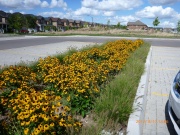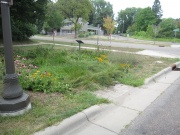LID opportunities in park lands
LID opportunities in parks
Parks range from simple parcels of municipal property to complex outdoor recreational facilities that include parking, sidewalks, trails, sports fields, field houses, operations facilities, and washrooms. Each distinct area of your site can be a source for runoff (referred to as a ‘source area’). These areas should be targeted when introducing LID in your park.
Targeting hard surfaces
Hard surfaces like parking lots and internal driveways are the most obvious areas to target for both stormwater quality and water balance improvements. These features produce more runoff than any other area on your site. Water quality of runoff from parking lots and driveways is typically more polluted than other source areas. Common water quality concerns include sand and salt from winter de-icing operations, and hydrocarbons (gasoline) and metals from vehicle breakdowns Runoff from vegetated areas of parks will be relatively clean and more closely match the natural water balance. On municipal park properties, hard surfaces are usually
located adjacent to pervious areas such as lawns, gardens or naturalized areas.
This makes an ideal location for a LID retrofit. Where grading allows, you can construct bioswales and bioretention areas in these green areas to pre-treat water prior to infiltration.
You can also design parking surfaces and internal roadways as infiltration systems using permeable pavement. This retrofit strategy can be combined with other LID practices. A pedestrian pathway paved with permeable pavement is another LID option for your park. They will reduce runoff volumes and encourage on-site infiltration. Pervious pipes are a viable option on many parks sites as well. They can be an alternative to conventional conveyance systems such as storm sewers. They encourage infiltration from hard surfaces and can be used to convey water to other LID features.
Accepting drainage from off-site areas
Does municipally owned land drain into your retrofit site? If so, this is an opportunity to provide stormwater controls for these areas. Roads are the most common source of runoff from external properties into parks. Treating municipal road runoff in a park requires planning input from municipal roads department staff. For these projects, the team must understand how all roads activities, including winter maintenance and potential roadwork, will affect the operation of LID practices in the park.
Inter-municipal transfer of funds
Integrating LID practices into the municipal stormwater management framework may change how municipal funds are managed. Traditional stormwater management maintenance resources and funds may have to be transferred to
a more landscape-based stormwater management maintenance program. Instead of infrequent but expensive stormwater management pond sediment removal operations, time and resources will be spent on more frequent but inexpensive maintenance projects including pruning and weeding bioretention practices or sweeping permeable pavement. Municipalities generally have the required staff and infrastructure within departments (e.g. arborist and horticulturalists in parks departments) to manage the maintenance of LID measures; however, funding this maintenance may require a transfer of funding and additional training.

